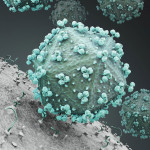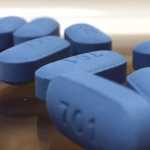Robert Coombs, MD, PhD, is associate professor in the department of laboratory medicine and medicine at the University of Washington at Seattle. Here, Coombs, an internationally recognized expert on HIV measurements, analyzes multiple viral load results of POZ founder Sean Strub.
Since different labs can obtain different viral load results with the same blood sample—and the same lab can make different findings using different types of tests—Sean decided to compare results from two labs using a total of three tests.
Quest Diagnostics ran two types of tests. On its standard Roche Amplicor HIV-1 Monitor test (not pictured), which measures down to 400 copies of HIV-1 RNA copies per milliliter of blood plasma, Quest reported that the virus was not detected. Analyzing the same blood sample with its HIV-1 RNA 2nd Gen ultrasensitive test—which measures down to 40 copies—it registered 99.0 copies/ml.
On the other hand, Specialty Labs (working for Clinical Diagnostic Services) ran its HIV-1 RNA UltraQuant, which measures down to 25 copies. That test reported Sean’s viral load as undetectable (shown as <25 copies/ml). And although this may seem confusing, I would say that there are no real differences among these three findings.
Why? There is an important distinction between the level of detection—the lowest amount of virus a particular test can measure—and the level of quantification—the point below which a test can’t reliably measure small variations in the amount of virus. For all currently licensed tests, the level of quantification is 200 copies and above. At lower levels, the tests are less precise. Thus, in my opinion, the widely used ultrasensitive tests have little measurement value beyond simply determining whether or not a person has detectable virus at the lower limit of detection.
Even at higher levels of virus, there is a three- to five-fold variability in viral levels. That means a viral load measurement from a given specimen could be up to five times higher or lower than the actual quantity. For example, the “true” viral load of someone who tests at 2,000 might range anywhere from 400 (one-fifth of 2,000) to 10,000 (five times 2,000). With “undetectable” readings, you have to presume that the viral level could actually be the number of copies down to which the test measures. In Sean’s case, all one can say for sure is that his true viral level is somewhere below 200 copies.
The problem is that many things can affect the findings. How the blood specimen is handled, labs’ varying performances, differences between assays, inherent imperfections of the biochemical techniques used, and day-to-day variations in blood levels of HIV can all influence the final results. Thus, I wouldn’t be at all concerned about that reading of 99. And I would remind everyone that therapy changes should never be considered without looking at the results of at least two recent viral loads and two recent CD4 counts and assessing them in the context of the overall clinical picture.
For Sean, it’s clear that aggressive therapy—his combination of indinavir (Crixivan), d4T (Zerit) and delavirdine (Rescriptor)—has resulted in the kind of viral suppression that we would wish for everyone. And his slow but steady CD4 increases over the years—most recently up to 412 cells—show immunological success. My advice to Sean and others who have good viral containment is to maintain their drug therapies and combine that with good general health care to help prevent viral activation. Keep immunizations up to date. Avoid infections, as much as possible. Eat and exercise well. And develop a positive attitude, understanding that with appropriate medical management, we can turn this into a chronic, manageable disease that you can live with






Comments
Comments